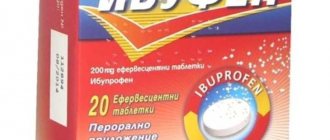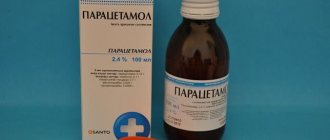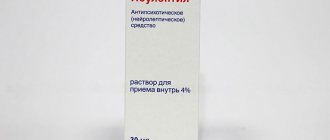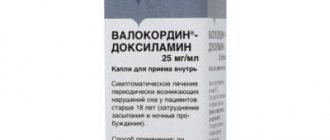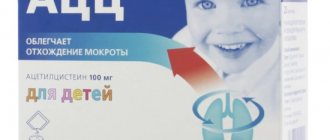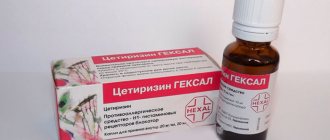Sulfanilamide drugs are known for having a fairly high antibacterial effect, so such drugs are often prescribed not only to adults, but also to children.
One of these representatives is Biseptol, which is available in several dosage forms, so after reading the instructions for use and reviews, today we want to talk in more detail about this product and when it is advisable to give it to children.
Release form
According to the official instructions for use, Biseptol for children is available in the following dosage forms:
- A suspension or syrup that has a sweet taste and pleasant aroma, so in most cases children drink the medicine with pleasure.
- Tablets with a dosage of the main substance of 120 mg and 480 mg.
- Liquid for injection. This form is used for children over 6 years old, and only if there is an emergency.
How to take Biseptol for children and adults
For ease of use, Biseptol is available in different dosage forms.
- The tablet form is available in two dosages:
- 120 mg - for children;
- 480 mg - for adults.
- Suspension for children with strawberry scent in a bottle of 80 ml. 1 dose - 5 ml contains 240 mg of active substances.
- Concentrate for preparing a solution for infusion. 1 ampoule contains 480 mg of active substances.
How to take Biseptol and in what dosage forms depends on the disease and age of the patient.
Treatment in adolescents and adults:
The minimum dose for treatment longer than 14 days is 480 mg every 12 hours. The standard dosage is 960 mg twice a day; for severe infections, the dose is increased to 1440 mg every 12 hours.
- The course of treatment for respiratory tract and ENT infections is ten days.
- Treatment of inflammatory diseases of the genitourinary system lasts from fourteen to twenty-one days.
- Diseases of the gastrointestinal tract are treated for at least five days.
- Treatment for infectious diseases of the genital organs (chancroid) lasts from seven to fourteen days.
- To treat acute urinary tract infections in women, “shock” therapy is used, in which a single dose is up to 2880 mg.
- Pneumonia is treated with 960 mg twice a day. The individual dosage is calculated at 30 mg/kg.
- Nocardiosis is treated at a dosage of 2880 mg for at least three months, acute brucellosis - four weeks, typhoid fever - three months.
Compound
Regardless of the form of release, the main component of the drug is co-trimoxazole, a substance consisting of two components: sulfamethoxazole and trimethoprim.
Additional components vary depending on the release form. The tablets contain:
- potato starch;
- talc;
- magnesium stearate;
- polyvinyl alcohol;
- methyl parahydroxy- and propyl parahydroxybenzoate;
- propylene glycol.
The suspension (syrup) contains the following auxiliary components:
- macrogol (polyethylene hydroxystearate);
- carmellose sodium;
- aluminum-magnesium silicate;
- citric acid monohydrate;
- sodium hydrogen phosphate dodecahydrate;
- methyl parahydroxybenzoate;
- propyl parahydroxybenzoate;
- liquid maltitol;
- sodium saccharin;
- strawberry flavor.
After reviewing the detailed composition indicated in the instructions, we can say the following: the drug in tablet form is safer, because it does not contain such a large number of different substances as in the suspension, which is especially important for children prone to allergies.
Interactions with other medicinal drugs and other types of interactions
Elevations of digoxin levels in the blood may develop during one-hour treatment with cotrimoxazole, especially in late-life patients.
Cotrimoxazole may inhibit the hepatic metabolism of phenytoin. After administration of co-trimoxazole at primary clinical doses, there was an increase in the dosing period of phenytoin by 39% and a decrease in metabolic clearance by 27%. When taking both drugs at the same time, there is a possibility of an undesirable increase in the effect of phenytoin. Close monitoring of such patients is necessary to monitor the level of phenytoin in blood plasma.
The effectiveness of tricyclic antidepressants may be reduced with one-hour administration of cotrimoxazole.
Sulfonamides, including sulfamethoxazole, can remove methotrexate from the point of binding with blood plasma proteins and interfere with the nitric transport of methotrexate, thereby increasing the concentration of active methotrexate and increasing yuchi yogo diyu.
Cotrimoxazole can be infused as needed in oral antidiabetic medications.
Like other antibiotics, Biseptol may reduce the effectiveness of oral contraceptives. Therefore, patients need to undergo additional prophylactic visits during treatment with Biseptol.
With one-hour administration of indomethacin and cotrimoxazole, the level of sulfamethoxazole in the blood may increase.
In summer-age patients who simultaneously took diuretics, especially the thiazide series, there was an increased incidence of thrombocytopenia with purpura.
It was reported that cotrimoxazole may delay the prothrombin hour in patients taking the anticoagulant warfarin (sulfamethoxazole may interfere with warfarin due to its interaction with plasma albumin). This should be considered in patients who are already taking anticoagulants when taking Biseptol. In such cases, it is necessary to regularly check the prothrombin hour and monitor the patient's blood throat time.
Patients who took cotrimoxazole and cyclosporine after Nina transplantation experienced a decrease in Near function, as measured by changes in serum creatinine levels. Please note that this interaction is due to trimethoprim.
Episodes of pancytopenia have been reported in patients who took a combination of trimethoprim and methotrexate (section “Peculiarities of Stagnation”). Trimethoprim has a low affinity for human dihydrofolate reductase, which is why it has a potent side effect of methotrexate, which leads to an unnecessary hematological interaction with methotrexate, zocrem when on the obviousness of other risk factors, such as summer age, hypoalbuminemia, impaired function of the brain and a change in the reserve of the cerebrospinal fluid. These undesirable side effects may occur when taking high doses of methotrexate.
Such patients should be treated with folic acid or calcium folinate to prevent hematopoiesis (uncomplicated treatment).
Please note that patients taking pyrimethamine-based drugs for the prevention of malaria have doses greater than 25 mg of pyrimethamine per day when taking cotrimoxazole once an hour. You may develop megaloblastic anemia.
Episodes of toxic delirium have been reported after one-hour administration of Biseptol and amantadine.
There is evidence that trimethoprim may interact with dofetilide in the galvanization of the nitric transport system. With one-hour administration of trimethoprim at a dose of 160 mg, a combination with sulfamethoxazole at a dose of 800 mg 2 times per dose and dofetilide at a dose of 500 mcg 2 times per dose for 4 days, there was an increase in the area under the curve "con" concentration - hour" (AUC) of dofetilide by 103% and maximum plasma concentration (Cmax) by 93%. Dofetilide may cause serious sac arrhythmias associated with a prolonged QT interval, including bidirectional sac tachycardia (of the pirouette type), which is directly related to plasma concentrations of dofetil I'm coming. One-hour dofetilide and trimethoprim contraindications.
Caution should be exercised if the patient is taking other medications that may cause hyperkalemia.
Also, acute administration of trimethoprim/sulfamethoxazole (cotrimoxazole) and spironolactone can lead to clinically significant hyperkalemia.
Acute administration of cotrimoxazole may increase the systemic exposure of drugs that are metabolized primarily by CYP2C8, including paclitaxel, amiodarone, dapsone, repaglinide, rosiglitazone and other drugs. itazon.
Paclitaxel and amiodarone have a narrow therapeutic index. If the patient is taking paclitaxel or amiodarone, consider the nutritional benefits of the alternative antibiotic.
Both dapsone and cotrimoxazole can cause methemoglobinuria. Patients withdrawing dapsone from a combination with cotrimoxazole should be monitored for methemoglobinuria. If possible, consider alternative methods of treatment.
Flow into laboratory displays.
Biseptol, and the trimetoprime wool, and enter the yogo warehouse, can be driven on the results of the vanity of the concentration of methotrexate in the Sirovatzi blood, carried out by the method of competitive stars with the biblings of the bacteriyalne -dioderedreductasis yak lіanda. However, when methotrexate is prescribed by the radioimmune method, interference does not occur.
Biseptol can change the reaction of creatinine by following the Jaffe method (increases the creatinine level by approximately 10%). Functional impairment of tubular secretion of creatinine may result in a significantly reduced level of creatinine clearance.
Prescribing cotrimoxazole at a dose of 160 mg trimethoprim and 800 mg sulfamethoxazole increases lamivudine exposure by 40% (with trimethoprim). Lamivudine does not affect the pharmacokinetics of trimethoprim and sulfamethoxazole.
Operating principle
The active components that make up the drug have bactericidal properties, which determines the effect of Biseptol as a whole. Once in the body, they inhibit the synthesis of proteins necessary for the active development of bacteria, disrupting it and provoking the death of pathogenic microbes.
The drug has a wide spectrum of action and fights against many pathogenic agents (enterococci, E. coli, pneumococci, salmonella, shigella, pneumocystis, etc.).
special instructions
If a child has a tendency to allergic reactions or pathologies of internal organs, treatment with Biseptol syrup should be carried out under the supervision of a specialist due to the high risk of side effects.
During the course of treatment with Biseptol, it is recommended to provide the child with a drinking regime. Lack of fluid in the body may change the effectiveness of therapy.
Special instructions when using the drug:
Biseptol syrup should not be taken simultaneously with thiazide diuretics; components from the syrup may enhance the effect of anticoagulants; when combining syrup with indomethacin, there is a possibility of changes in blood composition; the drug may enhance the effect of medications of the hypoglycemic group; specialists do not prescribe the drug in combination with diuretics; It is not recommended to combine Biseptol with drugs that affect blood composition; with long-term treatment with Biseptol, it is recommended to take a blood test; It is forbidden to take syrup in combination with dofetilide; Biseptol in combination with ascorbic acid can provoke the formation of sand in the urine; syrup is prescribed with caution if therapy with anticonvulsants is necessary;
medications from the group of local anesthetics reduce the effectiveness of Biseptol; taking Biseptol syrup may imply some restrictions in the child’s diet (experts recommend refraining from sweets, carbonated drinks and foods that can have a negative impact on the functioning of the digestive system during therapy); if there is a deficiency of folic acid in the child’s body or a malfunction of the thyroid gland, the drug should be taken only after consultation with a doctor; during treatment with Biseptol syrup, it is necessary to limit the consumption of foods rich in protein (beans, cheese, animal fats, green leafy vegetables and any varieties of cabbage); If after taking the syrup the child develops shortness of breath or a dry cough, then a re-examination is necessary.
Indications
For children, Biseptol can be prescribed in a variety of situations, such as:
- Infections of the upper and lower respiratory tract and infectious diseases of the ears (sinusitis, purulent otitis, bronchitis, pharyngitis, bronchiectasis, tonsillitis, pneumonia, laryngitis, pharyngitis, etc.).
- Infections of the genitourinary system (cystitis in various forms, urethritis, pyelonephritis, prostatitis, etc.).
- Infections of the digestive tract (salmonellosis, typhoid fever, cholera, bacterial diarrhea).
- Whooping cough, scarlet fever, furunculosis, purulent inflammation of the skin, osteomyelitis.
Showing
Infections caused by microorganisms sensitive to cotrimoxazole, and also:
- infections of the upper and lower respiratory tract and ear infections: acute chronic bronchitis, bronchiectasis, pneumonia (including pneumonia caused by Pneumocystis jiroveci
), sinusitis, otitis media; - Infections of the sechostatic system: acute and chronic cystitis, pyelonephritis, urethritis, prostatitis;
- infections of the herbal tract, including typhoid and paratyphoid fever (including treatment of chronic noses) and cholera (as a supplement to the renewal of electrolytes);
- Other bacterial infections caused by susceptible microorganisms: acute brucellosis, nocardiosis, actinomycetoma (allegedly caused by related fungi), American blastomycosis ( Paracoccidioides brasiliensis
).
For osteomyelitis - as a drug of the remaining line (for example, since vancomycin is contraindicated), as the sensitivity of multidrug-resistant patients is increased to cotrimoxazole.
Follow the official recommendations for proper stagnation of antibiotics, especially the recommendation for stagnation in order to increase resistance to antibiotics.
Contraindicated.
- Hypersensitivity to active substances, to sulfonamides and trimethoprim, or to any of the related substances.
- There is parenchymal disease of the liver.
- In severely impaired function (creatinine clearance < 15 ml/min), it is not possible to periodically measure the concentration of trimethoprim and sulfamethoxazole in blood plasma.
- Megaloblastic anemia, caused by folate deficiency.
- Immune thrombocytopenia caused by ingestion of trimethoprim and/or sulfonamides.
- Hematological disorders.
- Combination with dofetilide.
- Glucose-6-phosphate dehydrogenase deficiency.
- Do not keep children under 2 months of age.
- Porphyria.
- The remaining trimester of pregnancy and breastfeeding.
At what age is it allowed to take
In the instructions we find that the medicine in tablet form is approved for children from 3 years of age, but if it is necessary to use it for smaller babies, then it is possible to use a suspension or syrup, which is approved for newborns from two months.
You should not prescribe such a remedy to your baby on your own, although it is not considered an antibiotic, it is still a bactericidal agent, and it affects the further functioning of the gastrointestinal tract (GIT), so it is better to first consult a doctor who can not only prescribe the necessary therapy , but also the correct dosage, taking into account the individual characteristics of the child.
Indicated for use
A two-component drug is prescribed by a doctor to treat diseases caused by microorganisms susceptible to the drug. Infections that can be successfully treated are:
- Nasopharynx, upper respiratory tract;
- Urogenital excretory system;
- Gastrointestinal tract;
- Skin and soft tissues.
Reviews published about the drug Biseptol are mixed. The drug helped some children on the second day, while others had to refuse the prescribed treatment due to side effects.
Contraindications and side effects
The instructions devote a lot of space to contraindications and side effects. It states that Biseptol cannot be used if:
- The child has hypersensitivity to any component of the medicine.
- There is a history of renal failure or other kidney diseases.
- If there is liver damage or disease.
- The baby has a deficiency of glucose-6-phosphate dehydrogenase.
- The baby has blood pathologies such as leukopenia or agranulocytosis.
- Presence of thyroid pathologies.
- Deficiency of B vitamins in the body, in particular B9 and B12.
Adverse reactions, unfortunately, do occur, and they are as follows:
- dizziness;
- headache;
- depression of general condition;
- hematopoietic disorder;
- cough and shortness of breath;
- pain in joints and muscles;
- kidney dysfunction;
- convulsions;
- allergic manifestations on the skin.
If a child develops such symptoms, you should stop taking the drug and consult a doctor as soon as possible.
Side effects of the drug Biseptol
The most common side effects observed during treatment with Biseptol are from the digestive tract (nausea, vomiting, anorexia) and allergic skin reactions (rash, urticaria). Rarely, Stevens-Johnson syndrome, toxic epidermal necrolysis (Lyell's syndrome), acute liver necrosis, and aplastic anemia may occur. In addition, hemolytic, megaloblastic anemia, eosinophilia, methemoglobinemia, hypoprothrombinemia may develop; allergic myocarditis; chills, fever, photophobia, anaphylactic reactions, vascular edema, skin itching, Henoch-Schönlein disease, urticaria, erythema multiforme, allergic rashes, desquamation dermatitis, serum sickness, and rarely, periarteritis nodosa, lupus syndrome may occur. From the digestive tract - diarrhea, abdominal pain, anorexia, nausea, pseudomembranous colitis, vomiting, increased activity of liver enzymes and serum creatinine levels, stomatitis, glossitis, pancreatitis, hepatitis (sometimes with cholestatic jaundice). From the genitourinary system : renal failure, interstitial nephritis, nephrotoxic syndrome, anuria, increased levels of non-protein nitrogen and creatinine in the blood serum. Possible metabolic disorders - hyperkalemia, hyponatremia. From the nervous system : apathy, meningitis, ataxia, headache, depression, convulsions, hallucinations, increased excitability, tinnitus, peripheral neuritis. Sulfonamides are close in chemical structure to some antithyroid drugs, diuretics (acetazolamide and thiazides), as well as oral antidiabetic drugs, which may cause the development of cross-allergy. Hypoglycemia and increased diuresis are rarely noted. From the musculoskeletal system : arthralgia, myalgia. From the respiratory system : shortness of breath, cough, formation of infiltrates in the lungs. Possible weakness, feeling tired, insomnia.
Instructions for use and dosage
Biseptol in the form of tablets is given to children after meals, and it should be washed down with water. The dosage is prescribed depending on the age and clinical picture of the disease. The instructions indicate the following dosages:
- Children from 3 to 5 years old are allowed 240 mg of the drug per day, i.e. 2 tablets of 120 mg each.
- From 6 to 12 years – 480 mg, i.e. 4 tablets of 120 mg or 1 tablet with a concentration of 480 mg.
You should not give the entire dose at one time, but it is better to take the medicine 2 times a day, with a 12-hour break between doses.
The medicine in the form of a suspension is also given after meals. First, you need to shake the bottle of liquid well, measure out the required amount and let your baby drink. It is assigned as follows:
- Newborns from 3 to 6 months – 2.5 ml 2 times a day.
- Children under 3 years old – 5 ml 2 times a day (morning and evening).
- Toddlers from 3 to 6 years old are allowed 5-10 ml every 12 hours.
- Children from 7 to 12 years old are prescribed 10 ml of syrup or suspension 2 times a day.
- Adolescents over 12 years of age are prescribed an adult dosage, i.e. 20 ml in the morning and evening.
On average, the duration of treatment is 1-2 weeks.
Overdose
Symptoms of acute overdose
: tiredness, vomiting, diarrhea, colic, headache, vertigo, confusion, drowsiness, loss of fluidity, confusion of fluidity, fever, intellectual and visual disorders, chewing, changes in blood storage, severe episodes - crystalluria, hematuria and anuria.
Symptoms of chronic overdose
: suppressed hematopoiesis (thrombocytopenia, leukopenia, megaloblastic anemia), as well as other pathological changes in the blood picture due to folic acid deficiency.
Likuvannya
(depending on the symptoms): rinsing the mucus, stagnation of medicinal products that cause vomiting, strengthening of nitric excretion with forced diuresis (subsection is associated with the release of sulfamethoxazole), hemodialysis (peritoneal dialysis is ineffective). It is necessary to control the blood picture and the level of electrolytes. In the event of pathological changes, blood patterns or bleeding indicate a specific treatment. To improve the effect of trimethoprim on blood circulation, calcium folinate can be used at a dose of 3–6 mg orally for 5–7 days.
Interaction with other drugs
- According to the instructions, you should not take the medicine with milk, as it sharply reduces the effectiveness of the medicine.
- Before taking the drug, you should avoid foods that are quickly absorbed by the body and excreted from the intestines, for example, dried fruits.
- A maintenance diet is important during treatment. It is worth giving up fatty foods, peas, beans, cabbage and tomatoes for this period.
- Biseptol is not recommended for use simultaneously with aspirin and substances that inhibit hematopoiesis.
- You should also be careful when taking diuretics, as the drug increases the risk of thrombocytopenia.
- The instructions indicate that if you take Biseptol and hypoglycemic substances, indirect anticoagulants, phenytoin or methotrixate, it enhances the therapeutic effect of the latter.
Is it possible for children
A frequent question for doctors: “Is Biseptol an antibiotic or not? And can it be given to children? The mechanism of action of the combination of trimethoprim and sulfamethoxazole is to block cell division, and not to destroy them. The drug cannot be classified as an antibiotic; this antimicrobial agent was developed 30 years ago, the last registration in the Russian Directory of Medicines was in 2001. Studying the list of contraindications will require close attention; in rare cases, the doctor will recommend using an analogue.
- Useful to know: what to do if a child is allergic to antibiotics?
Analogs
There are many different antibacterial drugs that are not antibiotics that can be used as an analogue of Biseptol.
These include:
- Co-trimaxozole;
- Bactrim Forte;
- Bi-septin;
- Sulgin;
- Sulfadimethoxine;
- Sulfadimezin.
When is this drug prescribed: subtleties and nuances
The instructions for use of this drug indicate that it is successfully used to get rid of a number of pathologies. Moreover, they are not always of the same category. For example, Biseptol is often prescribed when:
- various diseases of the respiratory tract, which include such serious problems as pneumonia, bronchitis, etc.
- angina;
- sinusitis;
- otitis;
- various infections caused by intestinal pathogens;
- infectious and inflammatory processes occurring in the excretory system;
- skin infectious problems.
Biseptol suspension for children - reviews
- kreative91 shares his review. Her nephew lives with her, and in 3 months he was sick as many as 5 times. At his next appointment with the doctor, he was prescribed the drug in the form of a suspension. Despite all the contraindications and frightening side effects described in the instructions, they decided to try it and began giving Biseptol to the boy. They had a course of treatment for 10 days, and the child’s condition improved significantly, so she recommends this remedy.
- The daughter of a Lex-Ta user suffers from an anomaly in the development of the genitourinary system, so the nephrologist often changes medications to avoid addiction, so she was prescribed this drug in the form of a suspension. Although the drug is quite old, it is effective. There were no side effects and the baby felt fine.
- And here is the story of Region66. She has two kids, and they are often prescribed antibiotics, which does not reflect well on the future functioning of the gastrointestinal tract. One day she was advised Biseptol, because it does not have such a negative effect on the intestines and is quite effective. After reading the instructions, she began giving it to the kids, and the effect appeared after a few days.
- The daughter of user ula1981 goes to kindergarten, and it so happened that she was frozen and developed cystitis. She wrote often, even wrote down her bed at night. The doctor confirmed the diagnosis and prescribed Biseptol. On the 3rd day of treatment, a positive effect was already noticeable, and by the end of the treatment my daughter had fully recovered.
- User lola03 has a son, and he gets sick often, they even stopped going to kindergarten. He developed a cough that did not go away for a long time. We were treated with various medications, but there was no effect. Then the doctor recommended trying Biseptol. As a result, the cough decreased, but did not completely go away. In principle, there is an effect, and this therapy has significantly improved the baby’s condition.
Side effects
The main adverse reactions are skin reactions and mild gut-intestinal disorders, which occur in aphids in approximately 5% of cases.
Infections and parasitic diseases:
fungal infections, and candidiasis itself.
On the side of the blood and lymphatic systems:
leukopenia, granulocytopenia, thrombocytopenia, eosinophilia, agranulocytosis, anemia (megaloblastic, immunohemolytic, aplastic), methemoglobinemia, pancytopenia, neutropenia, polycythemia, hemolysis in a patient substances due to deficiency of glucose-6-phosphate dehydrogenase. Most often, changes in the blood side were mild, asymptomatic and reversible after taking the drug.
On the side of the immune system:
allergic reactions, and fever itself, drug-induced fever, angioedema, urticaria, anaphylactoid reactions and serum fever, nodular periarteritis, allergic vasculitis, allergic myocarditis, exfoliative dermatitis, systemic erythematosus, hypersensitivity reactions.
The ruined exchange of speeches and food:
elevated potassium level in blood syringes – in a significant proportion of patients with pneumonia caused by
Pneumocystis jiroveci
, high doses of trimethoprim decrease progressively, but in turn, the increase in potassium concentration in Syrovatsi blood. In patients with impaired potassium metabolism or nitric deficiency, or in those taking drugs that induce hyperkalemia, trimethoprim can often cause hyperkalemia (in up to 60% of patients) entiv), guide when stagnant at recommended doses. Close monitoring of potassium levels should be ensured in such patients.
Hyponatremia.
Hypoglycemia in patients who do not have diabetes may develop in the first few days of treatment. Particularly at risk are patients with impaired liver function, diseased liver or insufficient food, as well as those who take high doses of trimethoprim-sulfamethoxazole.
On the side of the psyche:
hallucinations, depression, apathy, insomnia, fatigue, sleep disturbance. Delirium and psychosis, acute in patients of the summer century.
On the side of the nervous system:
neuropathy (including peripheral neuritis and paresthesia), uveitis. Aseptic meningitis or meningitis-like symptoms, ataxia, cramps, vertigo, vomiting noise, headache, confusion.
On the side of the organs, breathing:
pneumonitis with eosinophilic infiltration, shortness of breath, cough, superficial respiratory tract, pulmonary infiltrates. Cough, cough, pulmonary infiltrates may be early signs of respiratory hypersensitivity, which is rarely a lethal effect.
On the side of the grass tract:
boredom (with or without vomiting), anorexia, stomatitis, glossitis, gingivitis, diarrhea, pseudomembranous enterocolitis, acute pancreatitis in seriously ill patients, gastritis, abdominal pain.
On the side of the hepatobiliary system:
elevated levels of transaminases and bilirubin, hepatitis, cholestasis, hepatitis, liver necrosis, biliary duct syndrome, fulminant hepatitis, inflammation of the liver parenchyma.
From the side of the skin:
visipannya. These side effects in most cases of lung disease appear quickly after taking the drug.
As with other medications, in addition to sulfonamides, even rare side effects include erythema multiforme, Stevens-Johnson syndrome, toxic epidermal necrolysis (Lyell's syndrome), purpura, Henoch-Schönlein purpura, photosensitive. Unknown: Drug infection with eosinophilia and systemic symptoms (DRESS)
On the side of the musculoskeletal apparatus:
arthralgia, myalgia, rhabdomyolysis.
On the side of the north and southwest roads:
impaired function of nitric deficiency, oliguria, anuria, interstitial nephritis, increased blood nitrogen level, increased blood creatinine level, crystalluria. Sulfonamides, including Biseptol, can enhance diuresis, sedation in patients with swelling, swelling of the cardiovascular system.
The drug contains methyl parahydroxybenzoate (E 218) and propyl parahydroxybenzoate (E 216), which may cause allergic reactions (possibly delayed).
Unnecessary effects in VIL-infected patients:
VILI-infected patients with frequent concomitant illnesses and their treatment should be treated with careful prophylaxis or treatment of pneumonia caused by Pneumocystis jiroveci
, from high doses of Biseptol. Apart from the small number of additional side effects, the profile of side effects in such patients is similar to the profile in a population of patients who are not HIV-infected. However, these side effects occur more frequently (in approximately 65% of patients) and are often more severe, which necessitates the need for an interrupted course of treatment with Biseptol in 20–25% of patients. entiv.
Zocrem, in addition, or with a high frequency, we were wary of lower-value unwanted reactions:
On the side of the blood and lymphatic systems:
What is important is neutropenia, but also anemia, leukopenia, granulocytopenia and thrombocytopenia, agranulocytosis.
On the side of the immune system:
fever, cause skin rashes, allergic reactions such as angioedema, anaphylactoid reactions and serum sickness, hypersensitivity reactions.
The ruined exchange of speeches and food:
hyperkalemia. In such patients, close monitoring of serum potassium level should be ensured; hyponatremia, hypoglycemia.
On the side of the psyche there is a breakdown:
hostric psychosis.
On the side of the nervous system:
neuropathy (including peripheral neuritis and paresthesia), hallucinations, uveitis. Aseptic meningitis or meningitis-like symptoms, ataxia, swelling, tremor in patients with Parkinson's type of disease, subcutaneous lesions in patients with apathy, swelling of the feet and wide gait, vertigo, noise in the ears.
On the side of the organs, breathing:
pneumonitis with eosinophilic infiltration.
On the side of the grass tract:
anorexia, boredom with or without vomiting, as well as diarrhea, stomatitis, glossitis, pancreatitis.
On the side of the hepatobiliary system:
elevated levels of liver enzymes/transaminases, cholestatic hepatitis, severe hepatitis.
From the side of the skin:
macular-papular rash, which quickly disappears after taking the drug, called itching, photosensitivity, erythema multiforme, Stevens-Johnson syndrome, toxic epidermal necrolysis (Lyell's syndrome), Henoch-Schönlein purpura.
On the side of the musculoskeletal apparatus:
arthralgia, myalgia, rhabdomyolysis.
On the side of the north and southwest roads:
impaired function of niro, azotemia, elevated creatinine level in blood syringes, crystalluria, sulfonamides, including Biseptol, can cause diuresis, cremation in patients with swelling, reports of diseases of the cardiac-vascular system.
Adverse reactions associated with infection with Pneumocystis jioverci (P.cairnii), which causes Pneumocystis pneumonia (PCP):
important hypersensitivity reactions, rash, fever, neutropenia, thrombocytopenia, elevated liver transaminases, rhabdomyolysis, hypocalcemia, hyponatremia I, hyperkalemia.
When high doses were used in PCP therapy, the severe hypersensitivity reactions that resulted from taking the drug were avoided. If there is a sign of suppressed cerebrovascular function, the patient should be treated with calcium folate deficiency (5–10 mg/day).
Important hypersensitivity reactions were observed in patients with PCP who were re-initiated with trimethoprim and sulfamethoxazole after an interval of a few days.
Rhabdomyolysis has been observed in IL-positive patients, so cotrimoxazole should be taken prophylactically or for the treatment of PCP.
Helpful information
Quite often we are faced with the fact that children sometimes have to be given broad-spectrum antibiotics, and today there is a huge range of such products.
Augmentin is considered a fairly common drug, and in some cases doctors may recommend Flemoxin Solutab or another representative of the antibacterial agents Hemomycin.
If this information is interesting to you or you want to learn more about these medications, we recommend that you read their instructions for use and reviews.
Have you ever given Biseptol to your baby, and what was the effect after treatment? Were there any side effects, or did the body respond well enough? Share your tips and reviews in the comments if you have had to deal with this medicine. And also do not forget to leave your feedback on the article you read.
